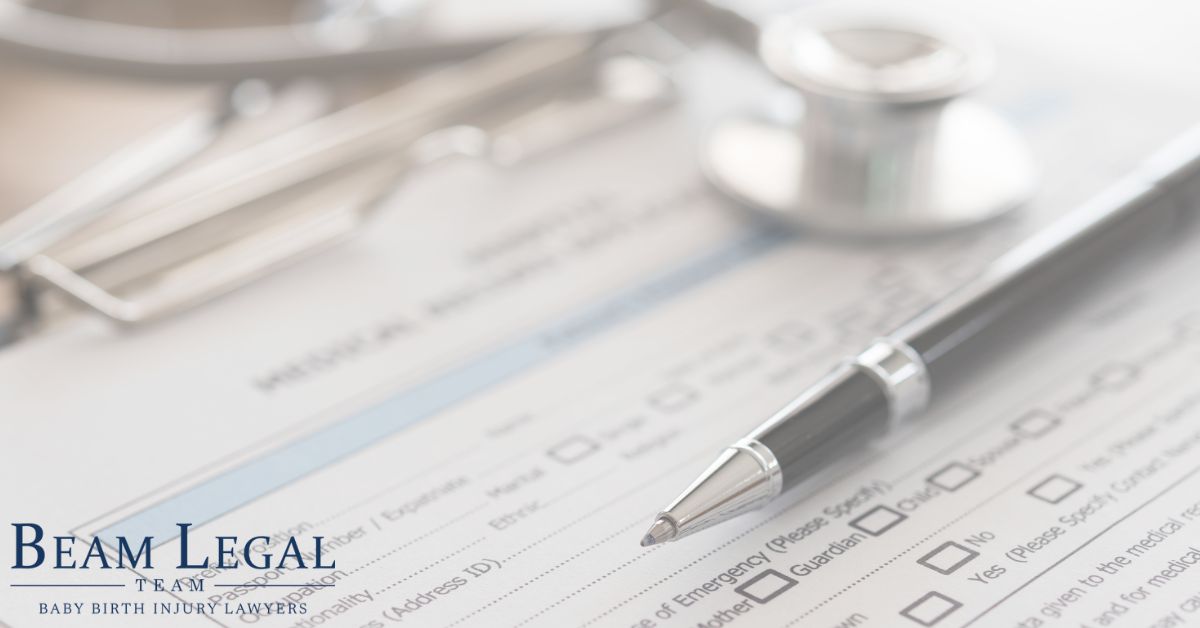
When your baby suffers a birth injury, the heartbreak is unimaginable. As a parent, you deserve to know how this happened and to hold those responsible accountable. Finding answers often involves filing a birth injury claim, reviewing medical records to understand what went wrong, and linking the injury to the provider’s actions.
Caring for a newborn with a birth injury can be overwhelming, and many parents don’t know what medical records are needed for their case. Learn what medical logs matter and how a Chicago birth injury lawyer at Beam Legal Team can help you present these treatment logs and recover compensation for your family.
How Medical Records Establish Negligence or Malpractice
Medical files are vital evidence that shows a provider’s actions and link them to your baby’s injury. These records document prenatal visits, labor, and delivery, including the mother’s health, the baby’s condition, and the medical team’s decisions.
Attorneys and medical experts will examine these documents to determine whether the medical team deviated from the standard of care. They may look for signs of negligence, such as delaying a needed C-section, misusing forceps, or missing signs of fetal distress.
If the evidence uncovers overlooked complications, missed diagnoses, or improper emergency responses, it may point to medical negligence, providing grounds to pursue a claim against the provider, hospital, or medical staff.
Types of Medical Records Relevant to Birth Injury Claims
Attorneys use a range of medical information to build a strong birth injury case, including prenatal history records, labor and delivery notes, and neonatal care reports.
- Prenatal Care Records: Prenatal documentation can include the mother’s medical history, routine ultrasounds, blood pressure logs, lab test results, and any genetic screenings performed. Each document helps identify potential health risks during pregnancy and whether these were appropriately managed to prevent complications.
- Labor and Delivery Notes: Documentation includes the delivery timeline, cervical dilation progress, intervention logs, and nurse shift reports. These details capture actions and decisions made during labor and show how the medical team responded to labor progression or emergencies.
- Neonatal Care Records: APGAR scores, immediate newborn assessments, and reports from resuscitation efforts or neonatal intensive care interventions reflect the baby’s initial condition. This documentation shows whether responses to complications at birth were timely and effective.
- Fetal Monitoring Strips and Heart Rate Tracings: Continuous monitoring logs track the baby’s heart rate and reactions to contractions. These recordings show any signs of fetal distress, like a drop in heart rate, and whether the medical team responded quickly.
- Surgical and Procedure Reports: Surgical and procedure summaries outline the reasons, timing, operation notes, and any complications. These accounts clarify if staff managed the interventions properly or if delays and errors influenced the results.
The Importance of Obtaining Medical Records Early
Birth injury claims can be complicated, and delays in collecting medical records make it harder to build a case. Hospitals and healthcare providers in Chicago are legally required to keep patient files for 10 years.
However, these documents can sometimes be misplaced, damaged, or lost. Facilities may also be slow to release documents or intentionally misrepresent available records.
Securing your medical files early safeguards evidence and gives your legal team the opportunity to investigate and file a claim within the eight-year statute of limitations in Illinois. If you suspect malpractice or negligence caused your birth injury, do the following:
- Request Patient Files Immediately: Reach out to the hospital and any involved healthcare providers to obtain a copy of all medical documentation related to the birth.
- Keep Detailed Notes: Document each step, including dates, contacts, and communication about your medical history.
- Verify Record Completeness: Once you receive the files, ensure they include all documents, such as prenatal, labor, delivery, and neonatal care notes. Missing sections can delay your case, so promptly request any overlooked documents.
- Check for Accuracy: Carefully review the documents for errors or inconsistencies in dates, procedures, or medications listed. If anything seems incorrect, address it with the provider immediately.
- Store Copies Securely: Keep digital and physical copies in a safe, easily accessible place to prevent loss or damage.
If you experienced a birth injury, reach out to an attorney who specializes in these cases as soon as possible. They can obtain crucial records, file a preservation of evidence order to ensure nothing is altered or destroyed, and start the legal process to protect your right to a settlement.
Protect Your Family’s Future and Right to Compensation
Preserving your child’s right to compensation after a birth injury means acting quickly to gather evidence and file a well-supported claim. At Beam Legal Team, our skilled attorneys understand the challenges you’re facing and can secure the records and documentation needed to hold the responsible parties accountable.
Contact us today for a free, confidential consultation to discuss your claim. Let us support you during this difficult time and help you obtain the resources you need for your child’s future.
